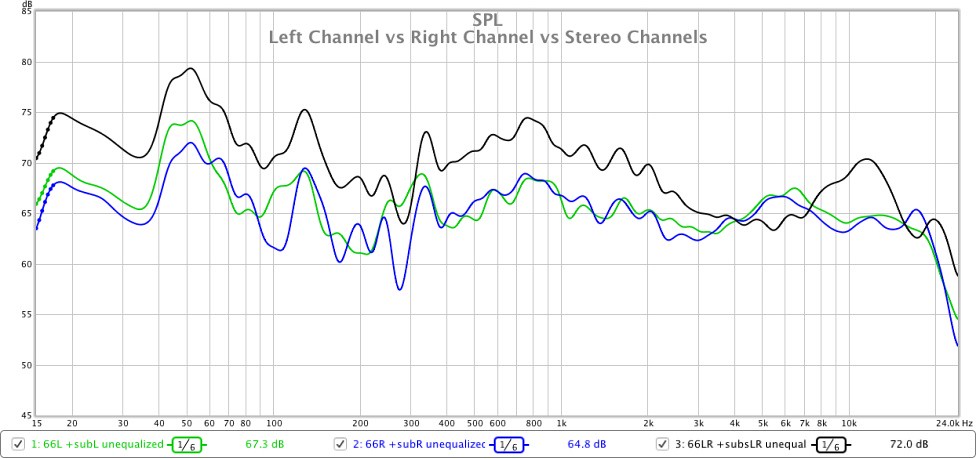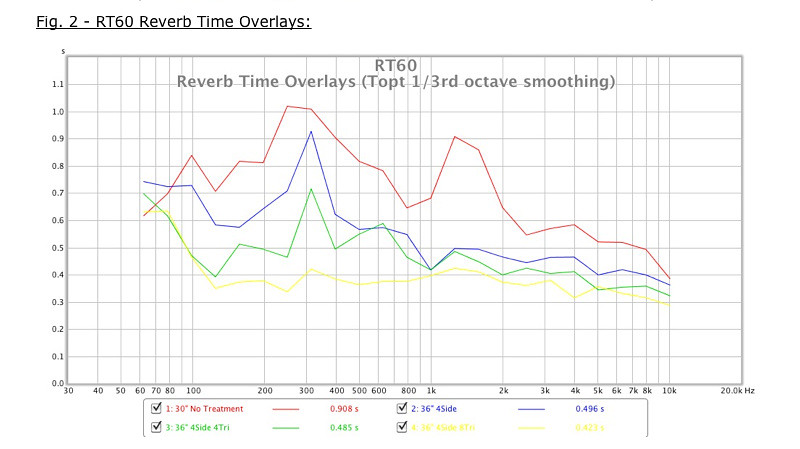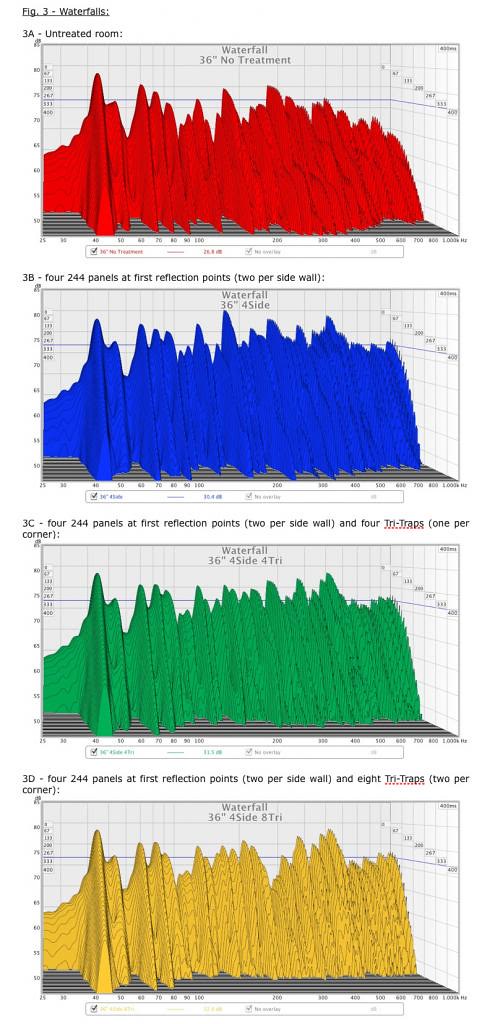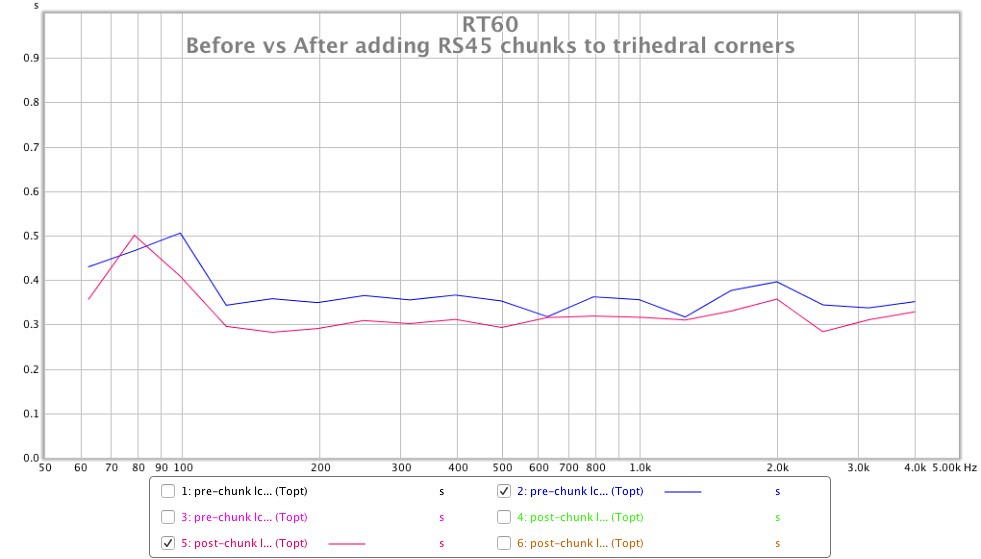DANOFDANGER
pfm Member
This was posted as a follow up on another thread of mine, but i relay it here for its own exclusive thread for others to see as its somewhat unrelated to the previous thread.
So i have done several measurements with different room furniture configurations and extended mattress treatment testing. All with interesting results. I even went as far as to remove all furniture except for my audio equipment and bed. Lets dive in.
Room dimensions 5.3m x 3.65m x 2.7m. Here is my modal simulations.

Ok so these are the measurements with all furniture removed except of course for my audio and video equipment. Also my bed remained.



These were the first measurements i made before i moved anything. Including draws on both side walls and various draws on the ends of the rear wall.



This is a comparison of with and without draws on the sidewalls (purple is draws removed, brown is with draws). Without any side furniture, the clarity and soundstage from doing this was much improved. Waterfall plot and spectrogram showed no real difference.

With and without my bed (brown is with, green is without bed). Without my bed was another nice change in clarity and take a look at the reduction in bass energy with the green (no bed), which shows some interactions with room modes going on. Waterfall and spectrogram showed no real difference.

Now on to the interesting part. Using my mattresses as acoustic treatment. These mattresses are heavy duty pillow top, not cheap old ones.
Using mattresses as side wall treatment at main reflection points. With and without (Pink is with treatment, Green is without). This offered the best quality improvements out of all the tests. Soundstage increased, imaging was noticeably improved. But the dynamic range was better. Hearing subtle sounds that were otherwise unnoticed previously. I attribute all this to the improved decay shown in the waterfall plot. Which was vastly reduced above 500hz.

Sidwall Treatment Waterfall Plot

Sidewall Treatment Spectrogram Plot

Next is using mattresses for rear wall treatment (green without, red with treatment). This had a similar increase in areas much like the sidewall treatment, but not nearly to the same degree. RT60, waterfall and spectrogram showed similar decreases in decay but again not nearly as well as the sidewall treatment.

Last is pushing the mattress into the front wall corner to act as a bass trap and also covers for sidewall treatment (Purple corner + sidewall and green without). But this lead to lower quality. I can only guess this was due to not a complete coverage of the sidewalls as when they were primarily placed as such. RT60 also showed worse results in comparison to only sidewall treatment.

To conclude, this allowed me to asses the differences that acoustic treatment would provide, both from measurements and audible differences. Sidewall treatment seems to be what will offer me the best audible improvements. Without any treatment. My room has excessive decay issues above 500hz and excessive bass energy below 100hz. I did not and will not be moving my speakers positions which could ultimately change some of these things, as their current position places them in the best possible configuration for soundstage (equilateral triangle) and imaging. The angle is unchanged also to allow the best on axis frequency response (moving off axis would only lower the high frequency rolloff).
Plan of action for treatment.
Because of the low decay in the high bass and low mid area, I am contemplating on using panels that are less effective below 500hz and primarily focus on energy above this frequency. So as to balance the decay as best as possible. I will place these panels on both the sidewalls and rear wall for a balanced effect. Even though when i used the mattresses as bass traps and found little effect. I believe that this doesn't mean bass traps dont work. It just means a mattress is not the best for this. So i intend to get some GIK soffit bass traps or tri traps with the optional range limiter to focus on bass energy only and a scatter plate fitted to keep the room as lively as possible.
Of course i invite anyone to look at the measurements i have made and offer any further advice as to the direction i should take with respect to acoustic treatment. I found it very interesting how much energy the mattresses could actually absorb (down to 60hz) when used as acoustic panels. Although an unrealistic solution for actual application. Thanks to those that insisted for me to get measurements done, it definitely has allowed me to make decisions on what and where.
So i have done several measurements with different room furniture configurations and extended mattress treatment testing. All with interesting results. I even went as far as to remove all furniture except for my audio equipment and bed. Lets dive in.
Room dimensions 5.3m x 3.65m x 2.7m. Here is my modal simulations.
Ok so these are the measurements with all furniture removed except of course for my audio and video equipment. Also my bed remained.
These were the first measurements i made before i moved anything. Including draws on both side walls and various draws on the ends of the rear wall.
This is a comparison of with and without draws on the sidewalls (purple is draws removed, brown is with draws). Without any side furniture, the clarity and soundstage from doing this was much improved. Waterfall plot and spectrogram showed no real difference.
With and without my bed (brown is with, green is without bed). Without my bed was another nice change in clarity and take a look at the reduction in bass energy with the green (no bed), which shows some interactions with room modes going on. Waterfall and spectrogram showed no real difference.
Now on to the interesting part. Using my mattresses as acoustic treatment. These mattresses are heavy duty pillow top, not cheap old ones.
Using mattresses as side wall treatment at main reflection points. With and without (Pink is with treatment, Green is without). This offered the best quality improvements out of all the tests. Soundstage increased, imaging was noticeably improved. But the dynamic range was better. Hearing subtle sounds that were otherwise unnoticed previously. I attribute all this to the improved decay shown in the waterfall plot. Which was vastly reduced above 500hz.
Sidwall Treatment Waterfall Plot
Sidewall Treatment Spectrogram Plot
Next is using mattresses for rear wall treatment (green without, red with treatment). This had a similar increase in areas much like the sidewall treatment, but not nearly to the same degree. RT60, waterfall and spectrogram showed similar decreases in decay but again not nearly as well as the sidewall treatment.
Last is pushing the mattress into the front wall corner to act as a bass trap and also covers for sidewall treatment (Purple corner + sidewall and green without). But this lead to lower quality. I can only guess this was due to not a complete coverage of the sidewalls as when they were primarily placed as such. RT60 also showed worse results in comparison to only sidewall treatment.
To conclude, this allowed me to asses the differences that acoustic treatment would provide, both from measurements and audible differences. Sidewall treatment seems to be what will offer me the best audible improvements. Without any treatment. My room has excessive decay issues above 500hz and excessive bass energy below 100hz. I did not and will not be moving my speakers positions which could ultimately change some of these things, as their current position places them in the best possible configuration for soundstage (equilateral triangle) and imaging. The angle is unchanged also to allow the best on axis frequency response (moving off axis would only lower the high frequency rolloff).
Plan of action for treatment.
Because of the low decay in the high bass and low mid area, I am contemplating on using panels that are less effective below 500hz and primarily focus on energy above this frequency. So as to balance the decay as best as possible. I will place these panels on both the sidewalls and rear wall for a balanced effect. Even though when i used the mattresses as bass traps and found little effect. I believe that this doesn't mean bass traps dont work. It just means a mattress is not the best for this. So i intend to get some GIK soffit bass traps or tri traps with the optional range limiter to focus on bass energy only and a scatter plate fitted to keep the room as lively as possible.
Of course i invite anyone to look at the measurements i have made and offer any further advice as to the direction i should take with respect to acoustic treatment. I found it very interesting how much energy the mattresses could actually absorb (down to 60hz) when used as acoustic panels. Although an unrealistic solution for actual application. Thanks to those that insisted for me to get measurements done, it definitely has allowed me to make decisions on what and where.


























